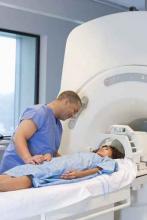according to results of a recent observational study.
These “substantial” radiation doses in some patients suggest that efforts are warranted to “justify, restrict and optimize” the use of radiological resources when possible, said Sudhir Krishnan, MD, of the Cleveland Clinic, and his coauthors.
“Although we were unable to assess or predict the potential long-term adverse effects of radiation exposure, judicious use of radiological resources is recommended,” Dr. Krishnan and his colleagues wrote in Chest.The retrospective, observational study included 4,155 adult admissions to a medical intensive care unit (MICU) at an academic medical center in 2013. Investigators calculated the cumulative effective dose (CED) of radiation based on reported ionizing radiological studies for each patient.
With a median length of stay of just 6.4 days, a total of 131 admissions (3%) accrued a CED of radiation of at least 50 millisieverts (mSv), the annual limit recommended by the National Commission on Radiation Protection, and 47 of those patients (1%) accrued a CED of radiation of at least 100 mSv, the 5-year cumulative exposure limit, the authors reported.
These findings suggest that “MICU patients could be subjected to radiation doses in a matter of days that are equivalent to or more than [the] CED observed in patients with chronic diseases and patients with trauma,” wrote Dr. Krishnan and his coauthors.
As hypothesized, patients with higher severity of illness scores (APACHE III scores) received a higher CED of radiation, according to the report. Using a multivariable linear regression model, investigators found that higher CED was predicted by higher APACHE III scores, sepsis, longer MICU stay, and gastrointestinal disorders and bleeding.
CT scans were the most common source of radiation exposure in patients who exceeded a 50 mSv of radiation, accounting for 49% of the total accrued dose, with interventional radiology accounting for 38%, authors reported.
Despite concerns about “the statistical risk of latent radiogenic cancer,” radiologic studies performed in the critically ill have the potential to reduce morbidity and mortality, the authors acknowledged in a discussion of the results.
“This understandably shifts the risk-benefit ratio towards radiation exposure,” the researchers wrote. “However, complacency in this regard cannot be entirely justified.”
Of the patients in the study who were exposed to a CED of at least 50 mSv, 81% survived the hospital admission and could be subjected to even more radiation as a part of ongoing medical care, they noted.
“Robust tools for monitoring CED prospectively per episode of clinical care, counseling patients exposed to high doses of radiation, and prospective studies exploring radiogenic risk associated with medical radiation are urgently required,” the authors said.
Dr. Krishnan and his coauthors reported no significant conflicts of interest.
SOURCE: Krishnan S et al. Chest. 2018 Feb 4. doi: 10.1016/j.chest.2018.01.019.



